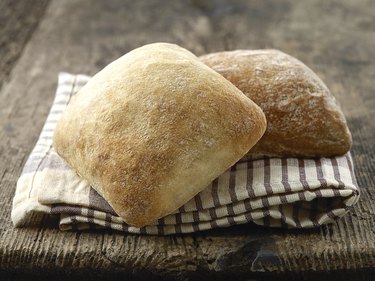
Ciabatta has the same basic ingredients as many other breads -- flour, yeast, water, oil and salt. But the difference is that the dough is extremely wet. During baking, the moisture content creates a soft, spongy center, while leaving the crust extremely crispy. Ciabatta isn't your healthiest type of roll though. Aside from carbohydrates, it has very few nutrients to offer.
Calorie Breakdown
Video of the Day
One 50-gram ciabatta roll, which is roughly 1.75 ounces, has approximately 120 calories. Since ciabatta does include oil, some of the calories come from fat -- about 15 percent of the calories are from fat. Around 15 percent of calories are from protein, while the final 70 percent of calories come from carbohydrates.
Video of the Day
Getting Good Fats
Monounsaturated and polyunsaturated fats are known to keep your blood cholesterol down and lessen your risk of cardiovascular disease. One of the best sources of these fats is olive oil, an ingredient in ciabatta. A 50-gram ciabatta roll gives you 2 grams of total fat, most of which is monounsaturated and polyunsaturated. Twenty to 35 percent of your caloric intake should come from fats, particularly these good fats, according to the Dietary Guidelines for Americans 2010. This means that for 2,000 calories, you'll need 44 to 78 grams of total fat. A single ciabatta serving takes up less than 5 percent of that amount.
Calculating Protein
Ciabatta isn't the best source of protein, although you will get around 5 grams from a 50-gram roll. Follow the protein recommendation outlined in the Dietary Guidelines for Americans 2010 -- 10 to 35 percent of your calories should come from protein. Aim for 50 to 175 grams of protein every day, based on 2,000 calories. Having a ciabatta roll gives you less than 10 percent of the requirement for a 2,000-calorie diet.
Counting Carbohydrates
The problem with ciabatta is that it gives you lots of quick-digesting, refined carbs but has little else to offer. Each 50-gram ciabatta roll gives you around 20 grams of carbohydrates. You can certainly have carbohydrates in your diet, although the carbs in ciabatta are primarily refined. Carbs are your body's main source of energy, so as much as 45 to 65 percent of your calories should come from them. For 2,000 calories daily, you're allowed 225 to 325 grams. In this case, that one ciabatta roll takes up close to 10 percent of your carb allowance.
Lacking in Fiber
Regular ciabatta bread made with white flour isn't particularly rich in fiber. You'll only get about 1 gram from a 50-gram roll. This is less than 4 percent of the 28 grams of fiber you need for a 2,000-calorie diet. Your fiber requirement might vary if your caloric intake is different. For every 1,000-calorie increment, get 14 grams of fiber in your diet, the Dietary Guidelines for Americans 2010 states. For an 1,800-calorie diet, aim for 25 grams. Or for a 2,200-calorie diet, you'll need 31 grams of fiber. If you're making ciabatta at home, opt for whole-wheat flour instead to get more fiber.
Micronutrient Considerations
Ciabatta bread made with enriched white or whole-wheat flour provides several types of B vitamins. You'll get small amounts of riboflavin, thiamin, niacin, pantothenic acid and folate, vitamins that work together to convert food into energy. But ciabatta is also high in sodium, giving you roughly 440 milligrams per 50-gram roll. Since you're supposed to have no more than 2,300 milligrams daily, that single roll takes up 20 percent of your allotment for the day.
- MyFitnessPal: Calories in Ciabatta Bread (Per 100g)
- U.S. Department of Agriculture and U.S. Department of Health and Human Services: Dietary Guidelines for Americans 2010
- Food.com: Ciabatta (Italian Slipper Bread)
- Food.com: Nutritional Facts: Ciabatta (Italian Slipper Bread)
- Harvard Medical School: Listing of Vitamins
- ChooseMyPlate.gov: What Counts as an Ounce Equivalent of Grains?